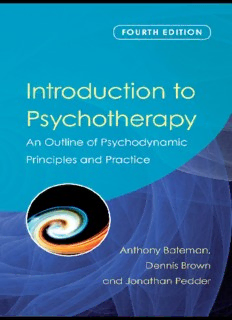
Introduction to Psychotherapy: An outline of psychodynamic PDF
Preview Introduction to Psychotherapy: An outline of psychodynamic
Introduction to Psychotherapy 4th edition This fourth edition of Introduction to Psychotherapy builds on the success of the previous three editions and remains an essential purchase for trainee psychotherapists, psychiatrists and other professionals. It has been revised and extended to capture some of the current themes, controversies and issues relevant to psycho- therapy as it is practised today. Bateman has added new chapters on attachment theory and personality disorder and has developed further the research sections on selection and outcome. His new chapter on further therapiescoversavarietyoftherapeuticmovementsandestablishes links between these and classical psychoanalytical therapies. Introduction to Psychotherapy is a classic text that has been successfully updated to provide a relevant and essential introduc- tion for anyone interested in psychotherapy. Anthony Bateman is a Consultant Psychotherapist at St Ann’s Hospital, London. Dennis Brown worked at the Group Analytic Practice in London and at the Institute of Group Analysis in London. Jonathan Pedder was Consultant Psychotherapist at the Maudsley Hospital in London. Introduction to Psychotherapy 4th edition An outline of psychodynamic principles and practice Anthony Bateman, Dennis Brown, and Jonathan Pedder Firstpublished1979byTavistockPublications Secondeditionpublishedin1991byRoutledge Thirdeditionpublished2000byRoutledge Fourtheditionpublished2010 byRoutledge 27ChurchRoad,Hove,EastSussexBN32FA SimultaneouslypublishedintheUSAandCanada byRoutledge 270MadisonAvenue,NewYork,NY10016 RoutledgeisanimprintoftheTaylor&FrancisGroup,anInformabusiness This edition published in the Taylor & Francis e-Library, 2010. To purchase your own copy of this or any of Taylor & Francis or Routledge’s collection of thousands of eBooks please go to www.eBookstore.tandf.co.uk. (cid:216)1979,1991,2000,2010AnthonyBateman,DennisBrownand JonathanPedder CoverdesignbySandraHeath Allrightsreserved.Nopartofthisbookmaybereprintedorreproduced orutilizedinanyformorbyanyelectronic,mechanical,orothermeans, nowknownorhereafterinvented,includingphotocopyingandrecording, orinanyinformationstorageorretrievalsystem,withoutpermissionin writingfromthepublishers. Thispublicationhasbeenproducedwithpapermanufacturedtostrict environmentalstandardsandwithpulpderivedfromsustainableforests. BritishLibraryCataloguinginPublicationData AcataloguerecordforthisbookisavailablefromtheBritishLibrary LibraryofCongressCataloging -in-PublicationData Bateman,Anthony. Introductiontopsychotherapy:anoutlineofpsychodynamicprinciples andpractice/AnthonyBateman,DennisBrownandJonathanPedder. – 4thed. p.cm. ISBN:978-0-415-47611-9(hardback)–ISBN:978-0-415-47612-6(pbk.) 1.Psychotherapy.I.Brown,Dennis.II.Pedder,Jonathan.III.Title. RC480.B31782010 616.89'14–dc22 2010004610 ISBN 0-203-84111-5 Master e-book ISBN ISBN:978-0-415-47611-9(hbk) ISBN:978-0-415-47612-6(pbk) Contents Foreword to the first edition vii Foreword to the second edition ix Foreword to the third edition xi Foreword to the fourth edition xiii Prologue xvii PART I Psychodynamic principles 1 Introduction to psychodynamic principles 1 Historical background to dynamic psychotherapy 6 The concept of conflict 11 Unconscious processe s 14 Anxiety and psychic pain 23 Defence mechanisms 28 Motivational drives 39 Developmental phases 45 Attachment theory 55 Models of the mind 59 Therapeutic relationships 68 vi Contents PART II Psychodynamic practice 91 Introduction to psychodynamic practice 91 Elements of psychotherapy 95 Levels of psychotherapy 109 Psychoanalysis and analytic psychotherapy 125 Group psychotherapy 153 Family and couple therapy 176 Social therapy 191 Encounter and beyond 205 Further therapies 222 Personality disorder 232 Selection 238 Outcome and research 254 Appendix 275 References 279 Name index 315 Subject index 325 Foreword to the first edition Wehaveoftenbeenaskedtorecommendsomeintroductorytextin psychotherapy, and felt at a loss. Freud’s papers on technique (1912a, 1913a) or Bion’s (1961) Experiences in Groups make fasci- nating if not essential reading forthose embarking astherapists on formal individual or group psychotherapy. Yet we were not aware of any one book – certainly none written by psychotherapists in this country – which answered basic questions such as ‘what is psychotherapyabout?’.Thisbook was born outofourattempts to answer that question and to convey something about dynamic psychotherapy to medical students and newcomers to psychiatry from various disciplines. We have been unashamedly simple in trying to delineate basic psychodynamic principles in Part I. We have described something of the range of methods based on these principles in Part II. We do not say very much about the practice of psychotherapy – that is ‘how to do it’ – for we believe that this can only really be learnt by embarking on the journey of explora- tion, either as patient or as therapist under regular supervision. We are both psychoanalysts working part-time as consultant psychotherapists in a teaching hospital psychiatric unit where all current opinions and treatments in psychiatry are represented. In ourviewFreud’sworkandpsychoanalysishaveprovidedthespring which has nourished all later forms of dynamic psychotherapy, be theyindividualor group psychotherapy,marital or family therapy. With the proliferation of newforms of psychotherapy, both within and beyond the fringe of psychiatry, we felt some simplestatement of basic aims and principles would help to orientate ourselves and, we hope, others. The psychoanalytic view is, among other things, essentially a developmentalone.Itseesmanagainsttheevolutionarybackground viii Foreword to the first edition ofhislongpre-humanandespeciallymorerecentprimatepast;itsees man in his historical and social setting; and lastly, it sees each individual in his own unique cultural and developmental context, which is our particular concern in psychotherapy. The present can onlybeunderstoodintermsofthepast.Thepastisever-present. Dennis Brown Jonathan Pedder St Mary’s Hospital, London 1979 Foreword to the second edition TheForewordtotheoriginaleditionbeganbyexplainingthatthere was a gap in the literature. Before 1979 there were no simple, comprehensive, introductory texts to which we could direct new- comers to psychotherapy. Clearly others were thinking along similar lines. In the same year Bloch (1979) edited a multi-author book describing a range of psychotherapies, and Malan (1979) produced Individual Psychotherapy and the Science of Psychody- namicswhichsumsupinvivideveryday language yearsofworking in this field at the Tavistock Clinic. In 1979 Whiteley and Gordon (1979) published a comprehensive survey of group methods in psychiatry, and Storr (1979) an account of his own approach to individual psychotherapy. Six years later came Casement’s (1985) lively description of the interactional process in psychoanalytic work. This was followed by Symington’s (1986) Tavistock Clinic lecturesonkeycontributorstomodernpsychoanalysis,andFrosh’s (1987) exposition of different developments within the psycho- analytictradition,andtheirimplicationsforculture.Allofthesewe would recommend to students of psychotherapy at different points intheirprofessionaldevelopment.Twoother bookshaveappeared which are of particular use to lay-people and potential patients: Knight’s Talking to a Stranger (1986) and Families and How to Survive Them by Skynner and Cleese (1983). Nevertheless, the steady interest in our book leads us to believe that it is of continuing value. It is regularly included in the reading lists for trainee psychotherapists, psychiatrists, and other profes- sionals, and it is often recommended to interested lay-people and prospective patients. It was meant as a brief and simple introductory overview to the many forms of dynamic psychotherapy and their origins in and
Description: